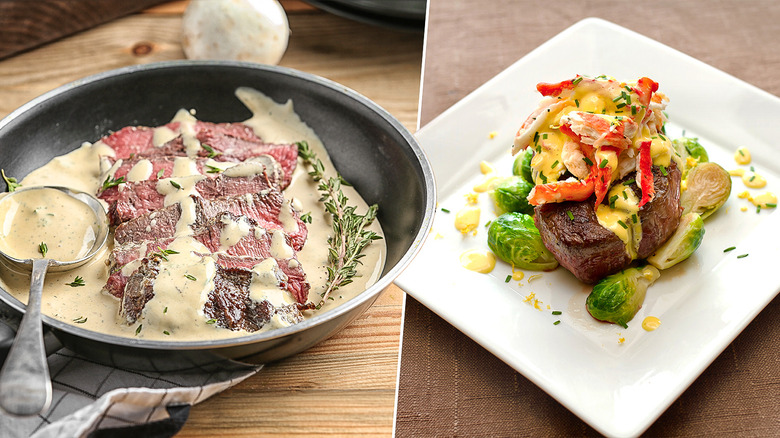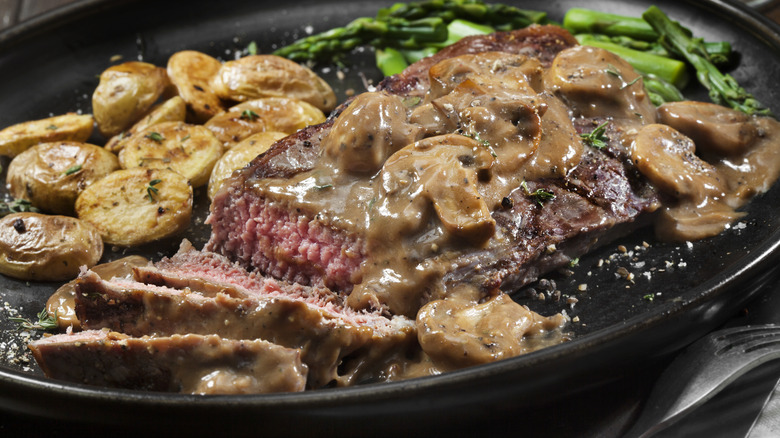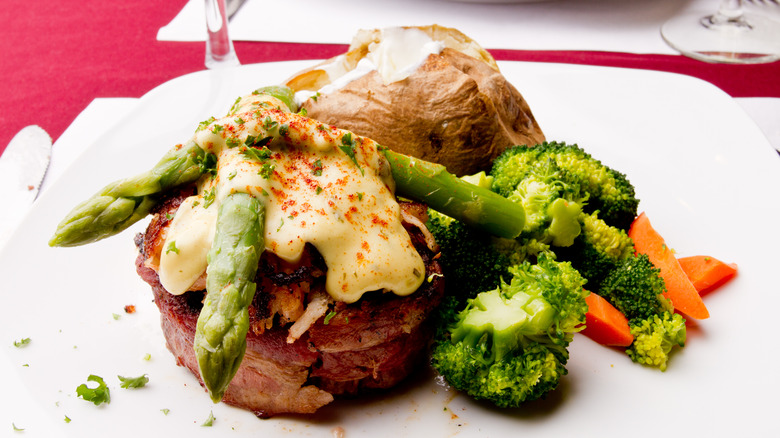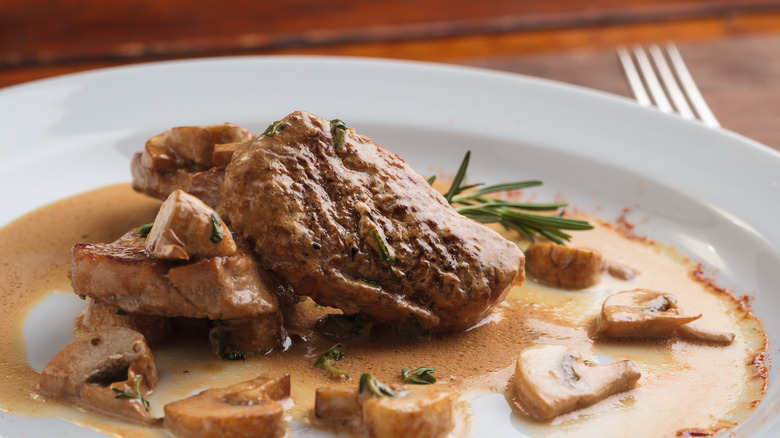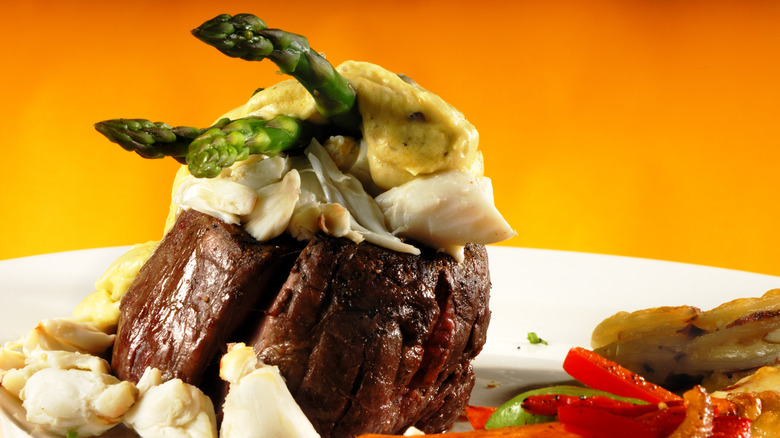What's The Difference Between Steak Diane And Steak Oscar?
If you're not already on a first-name basis with Diane and Oscar, we can help you get up to speed. These popular retro classics have been enjoying a much-deserved menu renaissance, perhaps due to nostalgia for simpler times or maybe because they look great in the social media stream. We think it's more likely that lucky diners have rediscovered the actual appeal of these two dishes – the fantastic flavor combinations that turn a simple steak into a special event.
The old style of naming a recipe after a notable person—for example, Peach Melba and Cobb Salad—was a way to capitalize on their popularity and create a sense of prestige. Steak Oscar was created for the King of Sweden and Norway in the late 1800s and includes a few of his favorite foods. Steak Diane's namesake is a little more debatable—Diane might refer to Diana, goddess of the hunt, even though it's not common to hunt cattle! Either way, the recognizable names of these two flashy restaurant dishes earned them enduring fame, possibly more so than their namesakes.
What is steak Diane?
When you order steak Diane, you just might get dinner and a show. The dish is composed of thinly pounded filet mignon steaks smothered in a reduction sauce of stock, cognac, mushrooms, and cream. As in many French-influenced recipes, the sauce is the star of the show here, with lean and lightly beefy tenderloin as a backdrop. It's possible the sauce was originally served with venison, hence the name, which refers to the mythical huntress Diana. But mushrooms are also common in sauces named after hunters, like French chasseur and Italian cacciatore, so there's room for imagination.
When tableside preparation was all the rage in mid-century America, steak Diane was a popular menu item. Waiters could quickly cook the thin scallops of beef in the dining room and finish the sauce in that same pan. The flammable cognac was added at the end of the sauce-making theatrics for a flaming finale. These days, you might find a more modern interpretation of steak Diane, with more flavorful cuts of steak or a lighter touch with the cream. Even if your steak Diane arrives plated from the kitchen directly, you'll get a taste of history from this continental classic.
What is steak Oscar?
As you might expect, King Oscar II of Sweden and Norway had regal tastes. His chef, as the story goes, created a dish encompassing his favorite treats — crab, asparagus, and veal — and topped the rich combo with buttery béarnaise sauce. In King Oscar's time, white asparagus was a luxury vegetable superior to the green variety, and likewise, tender veal was an elegant meat fit for a king. The original dish would have been a fairly pale-hued veal Oscar compared to the vibrant steak Oscar preparation of today: A juicy steak topped with asparagus (more often green than white), chunks of crab meat, and draped with tarragon-scented béarnaise.
Depending on the chef and restaurant, you might see the Oscar ingredient set used to top other meats, from pork to chicken breasts and even the original veal medallions. The combination makes an irresistibly rich surf-and-turf twist with a nice pop of color from asparagus tips.
The toppings differentiate steak Oscar from steak Diane
The most noticeable difference between the two steak preparations is the vegetable accompaniments served with the steaks. Steak Diane's signature umami flavor comes from its mushrooms, which are essential to the sauce and not merely an additional ingredient. This is not a flashy dish with showy garnishes — the flavor is the highlight. If you want to keep the focus on the meat, choose steak Diane for its simple elegance, which lets its beefy flavor take center stage.
Steak Oscar's indulgent ingredients, including crab, asparagus, and béarnaise sauce, are practically an entire second course. There's no need to choose between seafood and steak when ordering this dish — the surf-and-turf (with veggies included) plating could be one of its greatest attractions. If you love an elaborate Bloody Mary garnish, the complex combination that makes up steak Oscar might be your new favorite dinner; there's just more to enjoy on the plate.
Both sauces are based off of a French mother sauce, but the results are very different
The sauces used for the two steaks are also quite different, even though they come from a similar place. The pan sauce accompanying steak Diane comes from the espagnole family, one of the classic French mother sauces. Reduced beef stock adds texture and depth to the sauce and marries the flavors together with the steak it's served with. When plated, the steak, mushrooms, and sauce are all in shades of muted brown, but what the recipe lacks in color, it makes up for in savory flavor.
Steak Oscar's béarnaise sauce is from a very different branch of the sauce family tree. Composed of emulsified butter and eggs with a hint of shallot, reduced vinegar, and tarragon, béarnaise sauce takes more attention to perfect than the more forgiving pan sauces. The acidity of the tarragon vinegar is exactly the right touch for the lean crab and grassy asparagus. Béarnaise is a classic combination with steak, also thanks to that pop of acid. Some variations of steak Oscar call for hollandaise sauce, the lemony "mother" of béarnaise, which also has enough acid to carry the dish.
